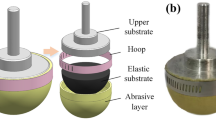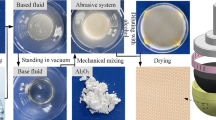Abstract
In this work, we reported a novel grinding method with high tangential grinding force and low normal grinding force using specially developed grinding tools. The tools were made of flexible composites based on the principle of liquid body armor and the shear thickening mechanism of non-Newtonian fluid. During grinding, abrasive particles are capable of generating a “hydro-cluster effects” under reverse tangential load, which lead to the decreased normal grinding force and the increased tangential grinding force. Hence, workpiece materials are removed under “high-shear and low-pressure” grinding mode. A serial of grinding experiments were carried out on Inconel718. The results showed that the novel grinding tool had an excellent grinding performance on Inconel718 workpieces. The value of surface roughness decreased from Ra 473.7 nm to Ra 153.0 nm under the optimal grinding parameters, i.e., wheel speed of 1 m/s, workpiece speed of 2000 mm/min, and grinding depth of cut of 180 μm. The surface defects of the Inconel718 workpiece were gradually removed. Meanwhile, the uniformed grinding textures were generated. The surface of the grinding tool had residual wear debris, and there was a little loss of grains after 240 grinding cycles.












Similar content being viewed by others
References
Wang PZ, He ZS, Zhang YX, Zhao SS (2017) Control of grinding surface residual stress of Inconel718. Procedia Eng 174:504–511. https://doi.org/10.1016/j.proeng.2017.01.174
Lu HJ, Jia XC, Zhang KF, Yao CJ (2002) Fine-grained pretreatment process and superplasticity for INCONEL718 superalloy. Mater Sci Eng A 326(2):382–385. https://doi.org/10.1016/S0921-5093(01)01521-0
Tso PL (1995) Study on the grinding of Inconel718. J Mater Process Technol 55(3):421–426. https://doi.org/10.1016/0924-0136(95)02026-8
Li Q, Gong YD, Cai M, Liu MJ (2017) Research on surface integrity in milling inconel718 superalloy. Int J Adv Manuf Technol 92(1–4):1449–1463. https://doi.org/10.1007/s00170-017-0080-0
Hood R, Soo SL, Aspinwall DK, Mantle AL (2018) Tool life and workpiece surface integrity when turning an RR1000 nickel-based superalloy. Int J Adv Manuf Technol 98(9–12):2461–2468. https://doi.org/10.1007/s00170-018-2371-5
Chen M, Sun FH, Lee YM, Yang SH (2004) Surface quality studies with respect to grinding burn of new typical nickel-based superalloy. Key Eng Mater 259-260:233–238. https://doi.org/10.4028/www.scientific.net/KEM.259-260.233
Tian YB, Liu F, Wang Y, Wu H (2017) Development of portable power monitoring system and grinding analytical tool. J Manuf Process 27:188–197. https://doi.org/10.1016/j.jmapro.2017.05.002
Wu CJ, Li BZ, Liu Y, Liang SY (2017) Surface roughness modeling for grinding of silicon carbide ceramics considering co-existence of brittleness and ductility. Int J Mech Sci 133:167–177. https://doi.org/10.1016/j.ijmecsci.2017.07.061
Godino L, Pombo I, Sanchez JA, Alvarez J (2018) On the development and evolution of wear flats in microcrystalline sintered alumina grinding wheels. J Manuf Process 32:494–505. https://doi.org/10.1016/j.jmapro.2018.03.023
Tian YB, Zhong ZW, Rawat R (2015) Comparative study on grinding of thin-walled and honeycomb-structured components with two CBN wheels. Int J Adv Manuf Technol 81(5–8):1097–1108. https://doi.org/10.1007/s00170-015-7114-2
Agarwal S, Rao PV (2010) Grinding characteristics, material removal and damage formation mechanisms in high removal rate grinding of silicon carbide. Int J Mach Tools Manuf 50(12):1077–1087. https://doi.org/10.1016/j.ijmachtools.2010.08.008
Sinha MK, Setti D, Ghosh S, Rao PV (2016) An investigation on surface burn during grinding of Inconel718. J Manuf Process 21:124–133. https://doi.org/10.1016/j.jmapro.2015.12.004
Dai CW, Ding WF, Zhu YJ, Xu JH, Yu HW (2017) Grinding temperature and power consumption in high speed grinding of Inconel718 nickel-based superalloy with a vitrified CBN wheel. Precis Eng 52:192–200. https://doi.org/10.1016/j.precisioneng.2017.12.005
Dai CW, Ding WF, Xu JH, Xu XP, Fu DK (2016) Effects of undeformed chip thickness on grinding temperature and burn-out in high-efficiency deep grinding of inconel718 superalloys. Int J Adv Manuf Technol 89(5–8):1841–1852. https://doi.org/10.1007/s00170-016-9192-1
Dai CW, Yu TY, Ding WF, Xu JH, Yin Z, Li H (2019) Single diamond grain cutting-edges morphology effect on grinding mechanism of Inconel718. Precis Eng 55:119–126. https://doi.org/10.1016/j.precisioneng.2018.08.017
Bhaduri D, Soo SL, Aspinwall DK, Novovic D, Martin D (2012) A study on ultrasonic assisted creep feed grinding of nickel-based superalloys. Procedia CIRP 1:359–364. https://doi.org/10.1016/j.procir.2012.04.064
Yao CF, Jin QC, Huang XC, Wu DX (2013) Research on surface integrity of grinding inconel718. Int J Adv Manuf Technol 65(5–8):1019–1030. https://doi.org/10.1007/s00170-012-4236-7
Gong YD, Zhou YG, Wen XL, Cheng J, Sun Y, Ma LJ (2017) Experimental study on micro-grinding force and subsurface microstructure of nickel-based single crystal superalloy in micro grinding. J Mech Sci Technol 31(7):3397–3410. https://doi.org/10.1007/s12206-017-0629-8
Li QL, Xu JH, Su HY, Lei WN (2015) Fabrication and performance of monolayer brazed CBN wheel for high-speed grinding of superalloy. Int J Adv Manuf Technol 80(5–8):1173–1180. https://doi.org/10.1007/s00170-015-7125-z
Li HN, Axinte D (2016) Textured grinding wheels: a review. Int J Mach Tool Manu 109:8–35. https://doi.org/10.1016/j.ijmachtools.2016.07.001
Mohamed AMO, Bauer R, Warkentin A (2014) A novel method for grooving and re-grooving aluminum oxide grinding wheels. Int J Adv Manuf Technol 73(5–8):715–725. https://doi.org/10.1007/s00170-014-5880-x
Peng RT, Huang XF, Tang XZ, Chen R, Hu YB (2018) Performance of a pressurized internal-cooling slotted grinding wheel system. Int J Adv Manuf Technol 94(5–8):1–16. https://doi.org/10.1007/s00170-017-1014-6
Durgumahanti USP, Singh V, Rao PV (2010) A new model for grinding force prediction and analysis. Int J Mach Tools Manuf 50(3):231–240. https://doi.org/10.1016/j.ijmachtools.2009.12.004
Nguyen T, Zhang LC (2009) Performance of a new segmented grinding wheel system. Int J Mach Tools Manuf 49(3–4):291–296. https://doi.org/10.1016/j.ijmachtools.2008.10.015
Malkin S (1991) Grinding technology: theory and applications of machining with abrasives. Int J Mach Tools Manuf 31(3):435–436. https://doi.org/10.1016/0890-6955(91)90088-K
Zhang DK, Li CH, Zhang YB, Jia DZ, Zhang XW (2015) Experimental research on the energy ratio coefficient and specific grinding energy in nanoparticle jet mql grinding. Int J Adv Manuf Technol 78(5–8):1275–1288. https://doi.org/10.1007/s00170-014-6722-6
Masoumi H, Safavi SM, Salehi M (2014) Grinding force, specific energy and material removal mechanism in grinding of hvof-sprayed wc–co–cr coating. Mater Manuf Process 29(3):321–330. https://doi.org/10.1080/10426914.2013.872261
He QY, Cao SS, Wang YP, Xuan SH, Wang PF, Gong XL (2018) Impact resistance of shear thickening fluid/Kevlar composite treated with shear-stiffening gel. Compos A Appl Sci Manuf 106:82–90. https://doi.org/10.1016/j.compositesa.2017.12.019
Gürgen S, Li WH, Kuşhan MC (2016) The rheology of shear thickening fluids with various ceramic particle additives. Mater Des 104:312–319. https://doi.org/10.1016/j.matdes.2016.05.055
Li M, Lyu BH, Yuan JL, Dong CC, Dai WT (2015) Shear-thickening polishing method. Int J Mach Tools Manuf 94:88–99. https://doi.org/10.1016/j.ijmachtools.2015.04.010
Acknowledgments
The authors gratefully acknowledge financial supports by the National Natural Science Foundation of China (Grant No. 51875329 and 51905322), Taishan Scholar Special Foundation of Shandong Province (tsqn201812064), Shandong Provincial Natural Science Foundation, P.R. China (Grant No. ZR2017MEE050), Shandong Provincial Key Research and Development Project, P.R. China (Grants No. 2018GGX103008), Scientific Innovation Project for Young Scientists in Shandong Provincial Universities, China (Grant No. 2019KJB030), and Key Research and Development Project of Zibo City, China (Grant No. 2019ZBXC070).
Author information
Authors and Affiliations
Corresponding author
Additional information
Publisher’s note
Springer Nature remains neutral with regard to jurisdictional claims in published maps and institutional affiliations.
Rights and permissions
About this article
Cite this article
Tian, Y., Li, L., Liu, B. et al. Experimental investigation on high-shear and low-pressure grinding process for Inconel718 superalloy. Int J Adv Manuf Technol 107, 3425–3435 (2020). https://doi.org/10.1007/s00170-020-05284-z
Received:
Accepted:
Published:
Issue Date:
DOI: https://doi.org/10.1007/s00170-020-05284-z




